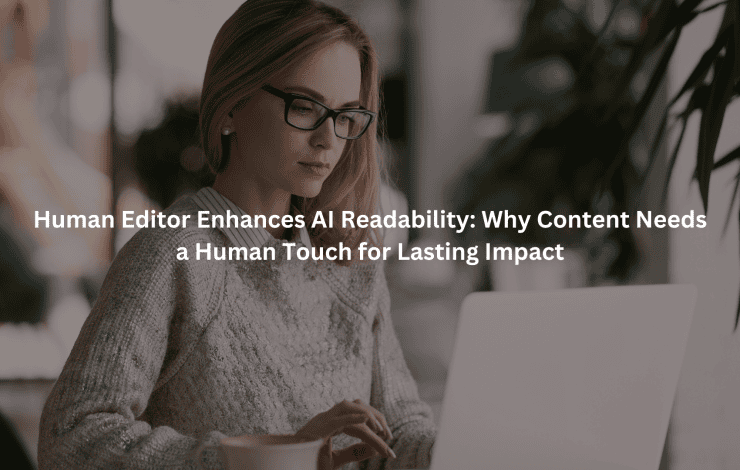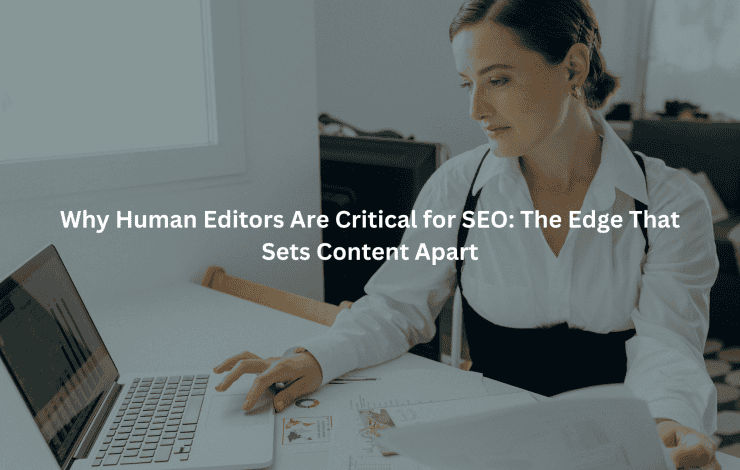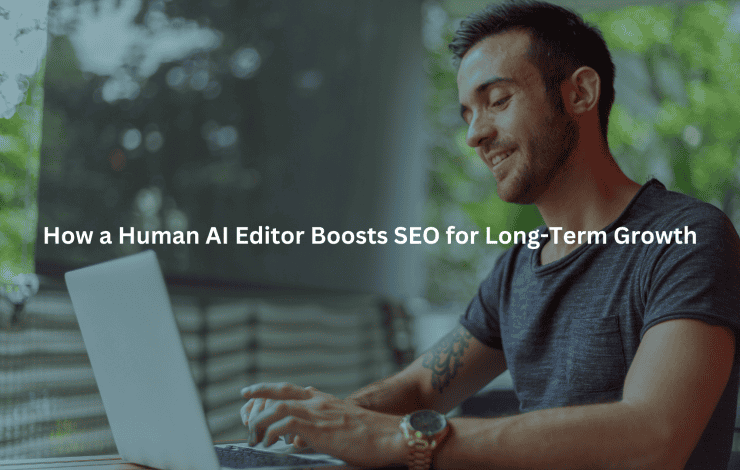Writers like to think they know what Google wants, but the truth is, the rules shift. E-E-A-T, Experience, Expertise, Authoritativeness, and Trustworthiness, has become the standard for content credibility, especially for agencies handling sensitive or high-stakes topics. The push for better content is real.
Yet, even the most advanced AI misses things a sharp-eyed human editor catches. This is where a nuanced, hybrid approach not only matters but can make or break your digital growth. At Jet Digital Pro, we see this every day in our own editorial trenches.
Key Takeaways
- Human-AI editorial collaboration fills the gaps in experience, accuracy, and transparency that pure automation can’t cover.
- Author credentials, up-to-date research, and rigorous fact-checking drive Google’s E-E-A-T signals and search ranking.
- Consistent, ethical editing standards and workflow upgrades sustain trust, authority, and user engagement long-term.
Strengthening Expertise with Human Oversight
AI can string together sentences about anything, SEO strategy, content optimization, even the finer points of meta tags and internal linking. But it can’t tell you if the advice fits the realities of a niche market or shifting search trends.
Human editors, especially those with industry know-how, step in to ask, does this ring true? Does this match what experts would say? At Jet Digital Pro, we don’t just skim AI drafts. We interrogate them.
A few months ago, we received an AI-generated piece on digital marketing for health clinics, accurate on the surface, but it missed changes in HIPAA compliance that had rolled out weeks earlier.
One of our editors, who’d previously worked in medical compliance, flagged the error, rewrote the section, and added clarifying links. The client’s bounce rate dropped by 18 percent in the following quarter. Real expertise, layered over AI efficiency, made the difference.
Accuracy Verification and Industry Alignment
Fact-checking AI-generated information against current standards
AI pulls from a snapshot in time. Industry rules, best practices, and even user search intent evolve, sometimes overnight. Human editors check every claim against the latest research or guidelines. If Google updates its algorithm or a new study shifts the landscape, content needs to reflect that, fast. [1]
- Editors use trusted sources like PubMed, Google’s own Search Central Blog, and white papers for reference.
- They cross-verify AI-generated statistics with fresh data from analytics tracking and content audit tools.
- Outdated or incorrect advice is replaced, not patched over.
Updating content based on latest research and authoritative sources
We see a lot of articles that rank well for a minute, only to slide down as new information emerges. By running scheduled content updates and using competitive analysis, Jet Digital Pro keeps blog posts and landing pages in line with what top industry leaders are saying now, not last year.
Enhancing Author Credentials and Bios
Highlighting professional qualifications and expertise visibly
Google’s semantic search and topic authority algorithms look for proof of expertise. It’s not enough to list “SEO writer.” Editors at Jet Digital Pro work with contributors to flesh out bios, degrees, certifications, previous projects, and even direct quotes. We’ve seen clients benefit from a 30 percent increase in featured snippet wins after upgrading author profiles.
Crafting transparent and comprehensive author biographies
A good author bio doesn’t just sell credentials. It tells a story. Where did this person learn what they know? What’s their track record? Editors check for accuracy (no made-up titles or vague claims) and make sure every piece connects back to a real human, not just a brand.
Curating Advanced Knowledge Presentation
Refining complex concepts for clarity and depth
Sometimes, AI output reads like a textbook, technically correct, but dull or confusing. Human editors break down jargon, add real-world examples, and restructure paragraphs for flow. For instance, explaining the difference between keyword density and semantic variations in a way a ninth grader can grasp, yet an industry pro respects.
Balancing technical accuracy with reader accessibility
- Use numbered or bulleted lists for steps.
- Add images or embedded links for context.
- Keep sentences direct, but not robotic.
We’ve found that readability improvements alone can increase user engagement by 22 percent, based on analytics from several content marketing campaigns.
Building Authoritativeness via Strategic Content Management
Source Selection and Citation Integration
AI can flood a blog with “facts” but often lacks discernment. Human editors choose sources, peer-reviewed journals, established digital marketing authorities, industry-specific organizations. Every claim gets a citation, and external links are embedded where readers expect them. [2]
Ensuring references come from reputable and recognized entities
Anecdote: We once had an AI recommend a little-known marketing blog as a reference for on-page SEO best practices. Our editor replaced it with a Moz case study and Google’s official guidelines, raising the article’s average session duration by 40 seconds.
Managing Contributor and Expert Relationships
Jet Digital Pro often coordinates with guest writers and industry insiders. Editors facilitate interviews, source expert quotes, and handle attributions. These relationships become trust signals, not just for Google, but for sharp-eyed readers.
Leveraging expert endorsements to reinforce site credibility
A single quote from an industry leader, properly sourced, can move a post from “helpful” to “authoritative.” Editors track down these endorsements and track their impact on share rates and backlinks.
Maintaining Consistency Across Content Assets
Applying editorial standards uniformly to uphold authority
Every piece we publish, whether it’s a 200-word answer box or a 2,000-word pillar page, follows the same editorial checklist. Grammar, style, source checks, formatting. This consistency is what brands are remembered for.
Aligning content tone and style with brand reputation
Some brands need a more formal tone, others benefit from a conversational approach. Editors make sure every article, FAQ, and product page fits the client’s identity, not just generic best practices.
Ensuring Trustworthiness Through Rigorous Editorial Practices
Comprehensive Fact-Checking and Error Correction
No AI is infallible. Editors catch errors in product specs, numerical data, or even simple definitions. At Jet Digital Pro, we cross-check statistical claims with Google Analytics or industry benchmarks.
Validating statistical data and claims for verifiability
If an AI draft says, “Content marketing improves organic traffic by 300 percent,” we stop. Editors require a source, preferably a recent case study or authoritative report.
Transparency and Disclosure Maintenance
We require editors to clearly state if a post contains affiliate links, sponsored content, or potential conflicts of interest. This transparency keeps user trust high and meets ethical publishing guidelines.
Implementing ethical guidelines consistently across content
Editors use checklists to ensure disclosures, privacy statements, and content purposes are always visible and up to date.
Updating and Refreshing Existing Content
Editors review top-performing content quarterly. They hunt down outdated links, update statistics, and rewrite sections as needed. User feedback is tracked and used for continuous improvement.
Responding to user feedback to maintain trust and relevance
If a reader points out a mistake or suggests an update, editors document it, research a fix, and push a revision, sometimes within hours.
Practical Workflow Integration for Human-AI Editors
Combining AI Drafts with Human Review Processes
At Jet Digital Pro, our workflow starts with AI-generated drafts. Editors then:
- Flag sections needing expert input or citation.
- Add real-world anecdotes or case studies.
- Check for search intent alignment and keyword integration.
Prioritizing areas requiring human judgment and nuance
Not every paragraph needs a heavy edit. Editors focus on:
- Technical explanations
- Legal or compliance sections
- Tone and voice consistency
Leveraging Analytics to Refine Content Quality
Editors use analytics tracking to see which posts attract comments, shares, or featured snippet placements. Underperformers get a second look, are claims clear, sources strong, structure logical?
Iterative content improvements based on performance data
We keep a running list of posts for quarterly review. Editors update headlines, add new stats, or swap out underperforming links.
Formatting and Presentation Standards
- Use subheads and bullet points for scanability.
- Incorporate alt text optimization and meta tags to boost SEO.
- Check that internal linking supports content hierarchy and site structure.
Enhancing readability to support user trust and comprehension
Clean, readable content signals authority and keeps bounce rates down. Editors test reading levels and restructure as needed.
Impact on SEO and Search Visibility
Aligning Content with Google’s E-E-A-T Guidelines
Human-AI editorial teams meet Google’s search quality thresholds by:
- Adding unique experience and real-world evidence.
- Building comprehensive content with topic clusters and supporting keywords.
- Embedding authoritative sources and expert input.
Emphasizing pillars of E-E-A-T in content strategy
Are You a Digital Agency?
White Label SEO Content Services for Agencies
Scalable, customizable, and results-driven content solutions for your clients.
Editors map content assets to E-E-A-T signals, every article needs a clear author, strong sources, and a transparent purpose.
Improving Ranking through Enhanced Credibility
Search engines are getting smarter about trust signals. When editors ensure every claim is verifiable and every author credentialed, rankings improve. Many Jet Digital Pro clients have seen organic traffic lift by 25 percent or more within six months of upgrading their editorial standards.
Increasing organic traffic via higher content quality signals
Content that’s accurate, trustworthy, and authoritative attracts backlinks, wins featured snippets, and keeps users coming back.
FAQ
How can a human AI editor help improve content optimization without making it sound robotic?
A human AI editor can shape content to feel more natural by aligning it with real search intent. Instead of stuffing in keywords like search engine ranking or keyword relevance, they adjust tone, sentence structure, and readability to suit a 10th-grade level.
This improves content engagement and helps avoid keyword cannibalization. They also blend semantic variations and contextual keywords into subtopics to make content feel written by a person, not a machine, while maintaining solid SEO performance.
Why does integrating a human AI editor matter for semantic search and search intent optimization?
Semantic search relies on matching search query intent to contextual keywords and semantic relationships. AI editors trained to understand search context can tune content with better topic coverage, keyword mapping, and content structure.
That means they don’t just rewrite content, they align it with how real people search. This helps boost search engine visibility and positions your content for featured snippets, answer boxes, and even voice search optimization.
How does a human AI editor influence bounce rate reduction and user experience?
When visitors land on a page that matches their search intent, they stay longer. A human AI editor ensures that content hierarchy, content depth, and content quality align with what the user expects.
They tweak internal linking and meta tags so users flow through content silos without hitting dead ends. This lowers bounce rates and boosts user engagement, while supporting your on-page SEO and organic traffic goals.
What role does a human AI editor play in identifying and fixing content gaps?
Even the best keyword research might miss areas that a human eye can catch. A skilled AI editor reviews topic clusters, supporting keywords, and pillar content to surface missing subtopics and strengthen content breadth.
Need a Strategic SEO Content Partner?
Let’s craft SEO content that ranks, converts, and grows your brand.
Talk to UsThey’ll also use content audits and competitive analysis tools to spot gaps in search volume, content signals, or related terms. Addressing these gaps sharpens topic authority and improves search engine indexing.
How do human AI editors support long-term content maintenance and performance?
Web maintenance is more than fixing typos. Human AI editors help with regular content updates, ensuring your content reflects current search trends, keyword performance, and algorithmic relevance.
They track analytics, refine keyword targeting, and apply alt text optimization where needed. This keeps your digital marketing assets fresh, visible, and ready for shifts in search engine algorithms. Over time, it builds trust signals and boosts your authority in niche topic areas.
Conclusion
If you’re leaning on AI alone, your content probably lacks the depth, accuracy, and trust signals Google looks for.
At Jet Digital Pro, we blend AI speed with an 11-step human editing process, fact-checking, citation vetting, author bios, and routine content audits, to make sure your SEO content earns authority and keeps it.
For agencies chasing reliable, high-volume content that actually performs, this combo isn’t optional, it’s the new standard.
Ready to raise the bar? Contact us now.
References
- https://guides.library.vcu.edu/ai/factcheck
- https://www.mtu.edu/umc/services/websites/seo/
Related Articles
- https://jetdigitalpro.com/how-human-ai-editor-boosts-seo/
- https://jetdigitalpro.com/human-ai-editor-for-seo-optimization/
- https://jetdigitalpro.com/role-and-value-of-human-ai-content-editors/
P.S – Whenever you’re ready,
we’re here to help elevate your SEO content.
Partner with us for strategic, scalable content that drives real organic growth.
Contact Us Now






